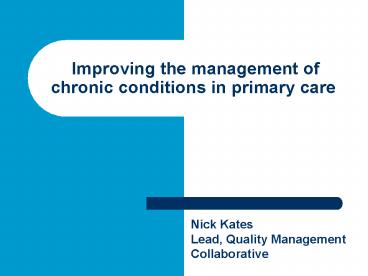Improving the management of chronic conditions in primary care - PowerPoint PPT Presentation
1 / 29
Title:
Improving the management of chronic conditions in primary care
Description:
... have and the health care we could (should) have lies not just a gap, but a chasm' ... U.S. Institute of Medicine - 'Chasm Report' ... – PowerPoint PPT presentation
Number of Views:37
Avg rating:3.0/5.0
Title: Improving the management of chronic conditions in primary care
1
Improving the management of chronic conditions
in primary care
Nick Kates Lead, Quality Management Collaborative
2
Chronic Disease - the Issue
- 66 of Ontarians over the age of 45 have a
chronic condition (CC) - 55 suffer from two or more chronic condition
- 80 of primary care visits are for a CC
- 67 of all hospital admissions are for a CC
3
Causes of Death in Ontario, 2000-01
4
Real Causes of Death (JAMA 20042911238)
Poor diet to Inactivity ratio Approximately 1.5
1
5
Chronic Disease - the Issue
- The Canadian health system doesnt do CDM very
well - lt30 of hypertensives have their blood pressure
properly controlled - 60 of diabetics have gone gt1yr without an eye
examination or a check for proteinuria - 60 of asthmatics are not properly controlled
- 20 of heart failure patients are readmitted lt60
days - 20 of patients with depression get guideline
based care
6
U.S. Institute of Medicine
Between the health care we have and the health
care we could (should) have lies not just a gap,
but a chasmUS Institute of Medicine, 2001
7
U.S. Institute of Medicine - Chasm Report
- These quality problems occur typically not
because of failure of good will, knowledge,
effort or resources directed to health care, but
because of fundamental shortcomings in the way
care is organized
8
Chronic Disease Management How to view it
- Another planet
- Relative test
- Visionary
9
Traditional Organisation and Culture
of Care
- Focus on acute problems
- Emphasis on triage and patient flow
- Short unprepared appointments
- Consumer initiated follow-up
- No consistent after-care
- Treat only those people who reach us
- Cant identify problems earlier
- No prevention of episodes / recurrence
- Brief didactic consumer education
- Emphasis on provider - not system behaviour
- Wagner 1998
10
Systems are perfectly designed to get the
results they achieve
Thought for the day
11
Chronic Disease Management
- Better management and outcomes of individuals
with chronic diseases requires changes in the
ways systems of care are organised
12
ONTARIO QUALITY HEALTH COUNCIL 2007 REPORT
- Ontario needs to emphasise CDPM
- Need to co-ordinate current initiatives
- Increase self-management support
- Need to make greater use of IT
- FHTs offer a great opportunity
13
CHANGING THE PARADIGM
- Focus on populations
- Focus on longitudinal care / closing the loop (a
system of care) - Requires teams
- Identified care co-ordinator
- Patients as partners
- IT support
14
CHANGING THE PARADIGM
- Not a model
- A way of conceptualising care
- A framework for re-organising care
- Applicable to any system
15
Chronic Disease Management
- Better management and outcomes of individuals
with chronic diseases requires changes in the
ways systems of care are organised
16
Chronic Care Model
Health System
Community
Health Care Organization
Decision Support
ClinicalInformationSystems
Resources and Policies
DeliverySystem Design
Self-Management Support
Prepared, Proactive Practice Team
Informed, Activated Consumer
Productive Interactions
Improved Outcomes
17
(No Transcript)
18
Key components CDPM Program
- Preparing the practice
- Registry
- Algorithm / flow sheet
- Individual care plans
- Self-management support
- Care manager
- Care Co-ordination
- Pro-active follow-up
- Links with community partners
19
Goals of CPDM Programs
- To increase detection rates
- To offer comprehensive treatment
- To monitor / follow-up individuals during / after
treatment - To enhance self-management support
20
Goals of CDPM Programs
- To develop information systems to support CPDM
- To base treatments upon best-available evidence
- To ensure the organisation supports these goals
- To build links with community partners
- To help build a healthier community
21
(No Transcript)
22
(No Transcript)
23
(No Transcript)
24
Implementing change in primary care
- Practice assessment
- Team development
- Quality improvement team
- Improvement model
- PDSA cycles
- Collaborative
- Monthly reporting
- On-site follow-up
25
Quality improvement teams
- Small group
- Physician, RN / NP, Business manager, other
health professional - Lead / oversee processes of change
- Review data and suggest adjustments
- Ensure key components of change are in place
26
PDSA cycles Plan Do Study Act
27
PDSA cycles Plan Do Study Act
28
A collaborative
- Representatives / leaders of a practice
- 5 200 practices
- Meet periodically over a 12 18 month period
- Learn with and from each other
- Proven but flexible formula
- Orientation plus learning sessions
- Can focus on 1 3 problems
- Motivation, plus workshops, plus working on their
own improvement
29
A collaborative follow-up
- Learning sessions
- Story boards
- Data extraction tool / registry
- Monthly reporting
- Rapid PDSA cycles
- On-site facilitation
- Spread








![Chronic Care Management: How To Do It Right? [Updated For 2022] PowerPoint PPT Presentation](https://s3.amazonaws.com/images.powershow.com/9683693.th0.jpg?_=202111150510)






















